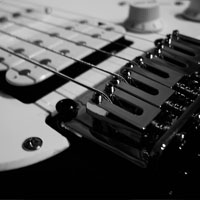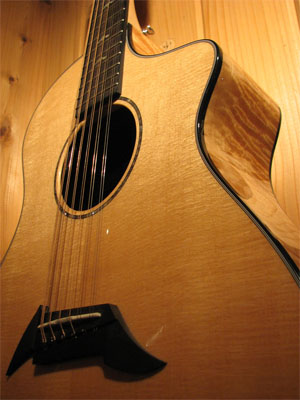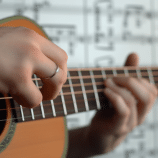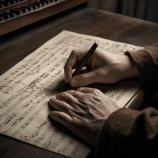The guitar is often typecast in music for film/tv and other media, and called upon only when a particular sound is needed: your cowboy western needs that Ennio Morricone/Bruno Battisti D’Amario twang. Your Bond-esque spy thriller wants that Vic Flick surf-jazz feel. Your hard-boiled cop movie needs a rough, rebellious, raunchy Eric Clapton lead. While the guitar is really useful in slotting in and hitting these (and many more) on the head, I think it’s full potential is actually overlooked.
I’m hoping to get you a little excited and thinking differently about the guitar, and maybe you’ll decide that it’s just he flavor you need to spice up your next score.
The Guitar – a Quick Overview
The guitar will typically come in two basic types:
Acoustic
- Western – a pear shaped hollow body with steel strings and a brighter sound, usually played with a pick/plectrum, or with the fingers
- Classical – a peanut shaped hollow body with nylon strings, and a mellower sound, usually plucked using the nails of the fingers.
Electric
Electric guitars come in many shapes and styles, and are either solid or hollow-body, with electronic pick-ups which (wait for it) pick up the vibrations of the strings. Electric guitars are patched into amplifiers which (wait for it) amplify the sound. Any number of effects may be employed during the signal chain, which dramatically or subtly change the sound.
The standard tuning on a guitar is (from low to high) E, A, D, G, B, E. It is scored on the treble clef, and sounds an octave below written. There are some specific things you have to keep in mind in order to score effectively for guitar which are beyond the scope of this article; for this, I heartily encourage you to check out this excellent article by Cameron Mizell on Musician Wages for a great primer.
Extended Techniques
Beyond the normal plucking, strumming, finger picking styles and the standard set of clean or distorted sounds you can get from a guitar, there are a myriad of additional possibilities. Many of these apply specifically to the electric guitar (as the application of effects is part and parcel of a player’s arsenal), but many can also be applied to acoustic guitars. These are also subject to the level of the player and their gear, so be sure to check and make sure what you are asking for is possible.
Volume Pedal
Typically, a note struck on a guitar has a percussive attack. You can shave off this attack an create a volume swell by using a volume pedal. When combined with a large reverb and a bit of delay, this can create a tremendous cinematic effect. It’s best used with full chords or slow moving melodic lines. You should provide plenty of time to allow for the swell to grow – it’s possible to do quicker work, but the guitar player has to coordinate left and right hands as well as the foot movement to open up the volume pedal. This effect works great alone to create a feeling of vast space or an empty, lonely, or floating feeling, and can be combined wonderfully with other instruments as a bed, or blended with a string section.
https://www.youtube.com/watch?v=kKhSG0HOry0
Slide
A slide is a metal or glass tube worn on a finger. When depressed lightly on the guitar strings, it allows the player to play the note at that position and ‘slide’ in a portamento to other notes. If laid over several strings, you can slide multiple-stops. Typically, this can give a very country or blues feel, but if used in slow moving material can give a wistful feeling to a melodic line and is especially haunting when combined with volume swells, as described above.
https://www.youtube.com/watch?v=9rbrWrTcyes
Harmonics
A number of natural and artificial harmonics can be played on the guitar. Especially useful are the natural harmonics found on the open strings at the 5th, 7th, and 12th frets. These can be played in combination to create a haunting, sparkling effect. Artificial harmonics are possible at all positions, by activating the string with the pointer finger of the strumming hand at 5, 7, or 12 frets above the note, and plucking with the thumb. This is a more advanced technique, and allows the guitarist to play entire chords as harmonics! These must be arpeggiated or otherwise separated and is slightly awkward, so be sure to give the player time to hit each note.
https://www.youtube.com/watch?v=GernDc6HWlQ
EBow and other pick/fingerpicking alternatives
An Ebow is a small electronic device held in the strumming side hand and placed above the string one wishes to ‘activate’. An electromagnetic oscillation will cause the string to start vibrating steadily and continuously until the e-bow is removed or turned off. A guitar played with an e-bow is a bit like a violin – there is no attack, but a steady sustained note. As the finger moves to the next note on a string it cuts the vibration a bit, so there is a volume swell effect each time. An interesting possibility is to track multiple lines to create a Ebow guitar choir as an unusual substitute for a string orchestra. Note: it’s only possible to activate one string at a time using an Ebow so make sure you are writing for a single string or allow time for string skips and the resulting break in the line. Some players may even be skilled at playing the guitar with an actual violin bow (thank you, Mr. Page), but this is pretty specialized.
Another interesting sound is to have the player finger the chords on the fretboard, but instead of strumming, knock the body of the guitar with their knuckles or flat of the palm. This is a very quiet percussive effect and includes a distinct (wow you guessed it) hollow knocking sound. Try knocking on different locations on the body for tonal variation. Knocking (gently!) with other materials can give a less muted strike; I often us a standard vinyl pick to knock at different places, including the body and the bridge of the guitar.
Alternate Tuning
Interesting possibilities exist for the guitar to be tuned away from it’s standard. However, unless you are a guitar player yourself (or can workshop with a guitar player), knowing how to score in an alternate tuning is tricky because certain intervals become awkward or impossible while other possibilities open up. Here are a couple of simple tuning suggestions which can be really useful in certain situations:
Tuning the low E string down a whole step to D (“Drop D” tuning) allows the first three strings to sound as an open fifth chord (D – A – D) – also known as a “Power Chord” for obvious reasons. This low, slightly slack tuning can be indicated if you want a really heavy, “beefy” sound for massive riffs or epic sounding chords and is especially effective if used with a compressed, overdriven, or crunch distortion. If you are trying to emulate current metal and hard rock styles, the drop D tuning will help you get that authentic sound. The low D string can also be played solo and when combined with palm muting (where the player mutes the strings with the palm at the bridge of the guitar) creates an deep, aggressive, and chunky growling sound.
https://www.youtube.com/watch?v=ACdIxrDiMDs
You can get a very interesting sound out of a western style acoustic by having the player tune the high E string down to match the B, so they ring in unison. Using these strings in unison can give the guitar a mandolin or bouzouki style sound. Depending on the player, you can write more Arabic or middle-eastern sounding stuff and have it come off quite well on guitar. In this case you would be writing Sul B as the player will be playing both the detuned E and B strings in unison (and that fact should also be marked on the score). 12 string guitars have an additional 6 strings that ring either in unison or an octave above the strings present on a standard 6 string guitar. If the player has access to a 12 string and you want to get a lo-fi, funky faux ‘ethnic’ sound, you might ask the player to tune his guitar down a whole step (or more!). Whether or not your player will be willing to do this is another matter, so be sure to consult with them ahead of time (and have a great guitar tuner handy)!
Playing at the headstock or tailpiece
The strings between the nut and the headstock can be played, giving an eerie, dissonant effect, especially when combined with copious amounts of reverb and delay. Some guitars even have a tailpiece after the bridge, and those strings can also be played – they are typically longer than those at the headstock, and thus will sound a little lower. If the player fingers chords at the same time as strumming the headstock, those stopped strings will resonate in sympathy, enhancing the ghostly shimmering. Great for chilling moments in thrillers and horror films.
https://www.youtube.com/watch?v=Hf6fHyf1O38
A note about guitars and guitar effects
Many guitarists may utilize effects such as flangers, delays, and reverbs. In the signal chain, these will are effectively insert effects, and will “print to tape”. If you want more control over effects you can request that a more dry signal is provided (ie: without delay or reverb), but note that in some cases you want to leave it to the guitarist and have the effect printed as it is part of their sound and they may be playing with or against it. Talk to your guitarist, and use your discretion!
In any writing we do, we are always looking for ways to develop our sound and give our work some signature and character. The guitar is a sleeper of possibilities waiting to be discovered, and these are only the start – you can take these sounds and process them to your heart’s content, turning them into truly singular sound scapes with a signature stamp. I hope I’ve got you thinking about some unique ways to give your next score some 6 string magic!






